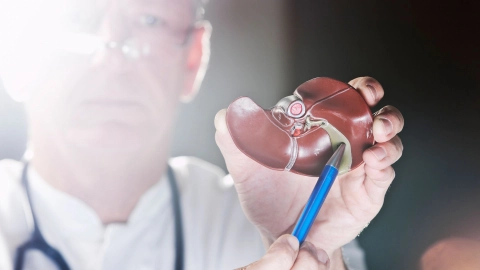ICD-Code C24.1: Malignant neoplasm: Ampulla of Vater
You have biliary tract cancer.
Bile is produced in the liver. The bile is transported via bile ducts within the liver towards the gallbladder. The bile is collected in the gallbladder. When you eat something, bile is released into the intestine. This is what the common bile duct to the intestine is for. A duct runs from the pancreas to the intestine. The bile duct and the pancreatic duct combine before running together to the intestine.
Your cancer is at the point where the two ducts meet. The tissue in the body is made up of cells. With cancer, the cells multiply uncontrollably, which leads to a malignant neoplasm (abnormal growth of tissue) developing. The cancer cells can destroy the healthy tissue and spread throughout the body.
Please note: This ICD code may also derive from the ICD-O system. If this is the case, there are usually additional letters and numbers in addition to the code. It starts with the letter M, followed by 4 digits and then a slash. There is another digit after the slash.
If it is an ICD-O code, then this does not describe a malignant cancer in all cases. The last digit after the slash gives you more detailed information about this:
- /0 – The tumor is benign. Cells in a tissue multiply uncontrollably. However, they are not destroying the surrounding tissue and are also not spreading throughout the body.
- /1 – It is not known for sure whether the tumor is benign or malignant.
- /2 – It is an early form of cancer, a precancerous stage where the cells are altered and multiply uncontrollably. However, they are not yet spreading beyond a certain margin and cannot spread to other organs either.
- /3 – It is a malignant cancer. The cells in the affected tissue are altered and multiply uncontrollably. They can destroy the surrounding tissue and spread throughout the body.
- /6 – It is a metastasis. Cancer cells have spread from the originally affected site to a different site in the body and have further multiplied there.
- /9 – It is either a malignant cancer or a metastasis. The cells in the affected tissue are altered and multiply uncontrollably. However, it is impossible to say whether these cells derive originally from the affected site or have spread there from a different site in the body.
Additional indicator
On medical documents, the ICD code is often appended by letters that indicate the diagnostic certainty or the affected side of the body.
- G: Confirmed diagnosis
- V: Tentative diagnosis
- Z: Condition after
- A: Excluded diagnosis
- L: Left
- R: Right
- B: Both sides
Further information
Source
Provided by the non-profit organization “Was hab’ ich?” gemeinnützige GmbH on behalf of the Federal Ministry of Health (BMG).

